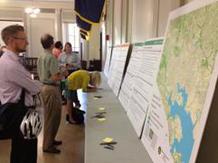In Case of Natural Disaster: Will you be ready?
Baltimore is highly vulnerable to many natural hazards, ranging from
coastal storms and flooding to extreme heat and high winds. There is strong
consensus that these types of extreme events will increase, both in frequency
and intensity, over the coming years. The increase in these natural disasters,
combined with climate change, create potential impacts that will notably affect the City’s
residents, businesses, infrastructure, and natural systems, and threaten
regionally significant assets.

Building upon the development of the 2013 Disaster Preparedness Project and Plan (DP3), the Department of Planning has
generated a behavior-change campaign centered on preparedness and increasing
community resilience. Natural disasters can happen any time and sometimes,
without warning. Preparing for these disasters ahead of time will help our
citizens deal with the potential negative outcomes such as no running water,
no electricity, no phone, and extreme conditions.
|
Be Prepared: "Make a Plan. Build a Kit. Help Each Other"
Join us on Earth Day, April 22, 2014, between 5:30pm and 8:00pm at Humanim, 1701
N. Gay Street, Baltimore, 21213
In celebration of Earth Day 2014, the Department of Planning's Office of Sustainability will host a resilience and preparedness event. This will provide the Department of Planning with an opportunity to collaborate with other city
agencies and partners around a simple and easy to understand preparedness
message- Make a Plan. Build a Kit. Help
Each Other.
This hands-on event will focus on increasing citizens' chances
of survival through the development of individual and family emergency plans and
emergency preparedness kits. The event will also focus on making our entire
community stronger and more resilient by working with citizens to identify
community assets, build stronger community ties, and identify areas for
improvement.
In
addition to making a plan, building a kit, and helping each other, the Preparedness Event will also have the following interactive activities:

- Youth activities area with
preparedness coloring books, poster competition, games, plant-your-own seed
station, and various other activities;
- Photo Booth with the Sustainability Turtle, our new mascot;
- “Tell Your Story” Video Booths that provide
citizens with an opportunity to document their stories from natural hazard
events that have impacted Baltimore City;
- Opportunities to sign- up to become
a Climate Ambassador, participate in free first aid and CPR classes, and become
a Community Emergency Response Team (CERT) member, and;
- The Annual Sustainability Report launch.
|
Please join us on Tuesday, April 22nd at Humanim, 1701
N. Gay Street, Baltimore, 21213. Drop in anytime between 5:30pm and 8:00pm to
make your own emergency plan, build your own kit, and build stronger community
ties. Children are welcome and encouraged to attend. Food and beverages will be
provided.
For more information, please contact Kristin Baja at Kristin.baja@baltimorecity.gov or visit Baltimore’s resiliency website http://baltimorehazards.wordpress.com/.
National Recognition for Baltimore's DP3:
The response to our recently completed DP3 has been extremely positive. The following are excerpts of some of the feedback we've received.
"We
work with many states and cities on climate resiliency issues, most recently
with our work for the Abell Foundation in Baltimore. As part of that work, I
had a chance to look carefully at your Disaster Preparedness Project and Plan
(DP3). I wanted to tell you that I think it is best plan I have seen in the
country that integrates the analyses and policy choices all cities face when
addressing climate adaptation and mitigation efforts. I know that there is more
work to do, but it provides a readable and sound round-map on these complex
issues. In particular, I was impressed with the electric power section, which
recommends a closer look at renewable options for power outages in severe
weather events. On that score, you are headed in the right direction, and we
are pleased to see the leadership of the city on those issues." -- Lewis Milford, Esq., President, Clean Energy Group
"The DP3 is one of the best plans I've seen out there that
incorporates both hazard mitigation planning and climate adaptation." -- Melissa Higbee, Program Officer, ICLEI- Local
Governments for Sustainability, USA
Have you Hugged a Turtle Lately?
If you join us at the Town Hall on April 22nd, you might just get your chance! |
|
 |
 Mentoring Future Generations of Planners
In March, the Morgan Association of Planning Students (MAPS) hosted its first Professional Development Institute at the Morgan State University Center for the Built Environment and Infrastructure Studies.
As part of the program to give planning students a first-hand look at the planning profession, Travis Pate, Demographic Specialist for the Department of Planning presented his work in support of the Casino Area Master Plan process.
Megan Griffin, an AmeriCorps VISTA with the Department, organized the event in her role as President of MAPS.
|
|